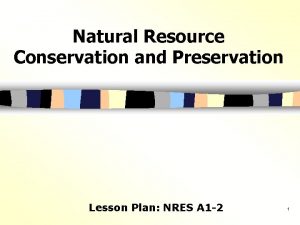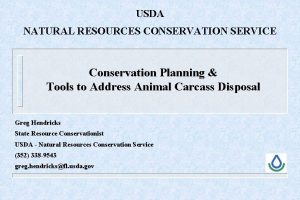Cultural Resources and Your Conservation Plan USDA Natural


- Slides: 2

Cultural Resources and Your Conservation Plan USDA Natural Resources Conservation Service What Are Cultural Resources? Do you enjoy looking at your family’s photograph albums or hearing stories about your parents and grandparents? Are family traditions important to you? Most of us are interested in our personal histories. We want to know about the past because it helps us recognize who we are, how we became what we are, and how we are similar, as well as different from others. In a broader sense, it is important to all of us to preserve the past--our North American cultural heritage--a legacy of over 10, 000 years. To learn about these deepest roots of human development is to learn something of what humanity is, what shapes it, and how much it can accomplish. It is sometimes difficult to piece together the story of humankind. These stories await discovery in the fragile traces of the past. We call these traces of the past cultural resources, and many of these traces are preserved on the surface and in the soil of our farms and cities. Simply stated, cultural resources are all the past activities and accomplishments of people. They include buildings, objects made or used by people (artifacts), locations and less tangible resources such as dance forms, stories, and holiday traditions. The cultural resources that the Natural Resources Conservation Service (NRCS) deals with most often are known as historic properties. These may be prehistoric or historic sites, buildings, structures, features, or objects. The most common type of historic property NRCS employees encounter is non-structural archaeological sites. These often extend below the soil surface and must be protected during installation of conservation practices that disturb the earth at the site. Cultural resources are non-renewable. There is no way to “grow” a new archaeological site or historic barn once it has been destroyed. Why Does NRCS Care About Cultural Resources? For Resource Conservation: NRCS considers cultural resources in its conservation planning for the same reason it protects the natural resources --the soil, water, air, plants and animals -- on your property. Keeping natural resources in balance helps provide the basis for a healthy and profitable farm environment; keeping cultural resources provides the basis for understanding our human past. We are all stewards of the soil and water on our property, the organisms that inhabit it, and the heritage information that it contains. Because It’s the Law: Recognizing the importance of cultural heritage, the United States Congress passed the National Historic Preservation Act (NHPA). This Act established a national policy for protecting our important cultural resources. The NHPA requires Federal agencies to consider cultural resources in its activities and determine if significant historic properties will be adversely affected by those activities. The Kentucky Heritage Council is tasked to coordinate and oversee compliance and protection efforts. The Kentucky Archaeology Survey is tasked with cataloging and sorting important or retrieved artifacts. Both organizations maintain records of known site location and those eligible and/or listed on the National Register of Historic Places. Nationally, NRCS has established procedures for training its field personnel and Conservation District (CD) partners to recognize cultural resources during conservation planning and to protect those resources from earth-disturbing conservation activities.

Cultural Resources Field Procedures In Kentucky, NRCS has established procedures to identify, evaluate and avoid the destruction of important cultural resources. Any practice that requires federal assistance, receives federal funding, or requires a federal permit must follow these cultural resources protection procedures. Step 1: Decide if the proposed conservation activity is an earth-disturbing undertaking. The most common conservation undertakings are grassed waterways, terraces, dams, diversions, tiling, landclearing, water storage facilities, and wetland restorations. Step 2: Determine the entire area that will be altered during construction of conservation practices. Step 3: Review state-managed archeological records and Look over the area for evidence of cultural resources. This step will be performed free of charge by your trained NRCS/CD conservationist. Step 4: Avoid the cultural resource if present. This may involve moving the location of the practice or selecting a different, non-destructive conservation practice. Most projects with cultural resources present will come to this conclusion. Step 5: If the cultural resource cannot be avoided, a professional archaeologist or historian will evaluate the importance of the historic property. The expense of professional investigation is the responsibility of the landowner, and cannot be supported with cost-share funds. NRCS in Kentucky will strive to provide this professional assistance free of charge to all program participants, budget permitting. Step 6: If the cultural resource is determined to be non-significant, the landowner and NRCS may proceed with the conservation practice. However, if the resource is significant, and an alternative practice cannot be agreed on, the cultural resource must be “mitigated. ” Mitigation is an action that reduces the harmful impact, and may consist of moving a historic building out of harm’s way or documenting its architecture before destruction; excavation of an archaeological site; or building a protective barrier around the historic property. There may be occasions when the landowner does not want to pay for site evaluation or mitigation. If no alternative conservation plan can be implemented, NRCS will withdraw assistance on conservation activity at that site, and the landowner may proceed with the conservation practice only at their own expense. Procedure for Discovery During Construction Private Property Rights and Kentucky Burial Protection Laws If artifacts, building foundations, or human remains are uncovered, the contractor must stop work and NRCS must be contacted. The NRCS conservationist will take steps to protect the site until it can be evaluated for significance. Steps 5 and 6 above will be conducted. Landowners with historic properties on their land have ownership of that historic property with the exception of human remains, grave markers (including burial mounds) and artifacts found in association with graves and human remains. Human burials and their associated objects are the property of the state. Non-grave artifacts from archaeological sites and historic buildings are the property of the landowner. A landowner may choose to disturb a historic property, but they cannot receive federal or state assistance to do so. If an earthmoving activity disturbs human remains, the landowner is required to contact the county coroner or Sheriff within 48 hours. September 2002 The United States Department of Agriculture (USDA) prohibits discrimination in its programs on the basis of race, color, national origin, sex, religion, age, disability, political beliefs and marital or familial status. (Not all prohibited basis apply to all programs). Persons with disabilities who require alternative means for communication of program information (Braille, large print, audiotape, etc. ) should contact the USDA Office of Communications at (202) 720 -5881 (voice) or (202) 720 -7808 (TDD). To file a complaint, write the Secretary of Agriculture, U. S. Department of Agriculture, Washington, D. C. 20250, or call (202) 720 -7327 (voice) or (202) 720 -1127 (TD). USDA is an equal employment opportunity employer.



